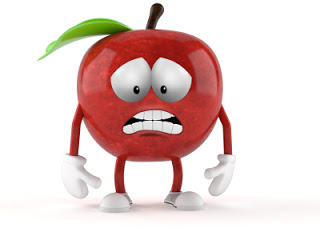Ladies and gentlemen, children of all ages (nope, not talking about the circus) all have unpleasant changes in their bowel movements bloating or gassiness from time to time. For some, these GI symptoms are a daily struggle. I’ve had clients who have dabbled in lactose free or gluten free with little improvement. A couple of years ago, I learned of the Low FODMAP diet. FODMAP stands for Fermentable Oligo-, Di- and Mono-saccharides, and Polyols. God bless the acronym.
The science: high FODMAP foods are poorly absorbed in the small intestine which leads to bacterial fermentation in the colon and then bloating, pain and gas in susceptible individuals. So what foods are these? Fruits such as apples and pears, many vegetables including onions, garlic, asparagus, wheat (because of it’s fructan content not the gluten), most artificial sweeteners and legumes.
It’s generally suggested to first eliminate all high FODMAP foods and then be sure to keep total FODMAP content in your diet low. There’s a threshold effect so a little bit may be fine but in combination…. watch out. A recent Wall Street Journal article talked about the low FODMAP concept, which originated in Australia, gaining support in the US. The results from the studies done are impressive with figures around 75 to 80 percent of participant’s symptoms improving. I have introduced the FODMAP system to many clients but have a nutrition colleague, Gina Casagrande aka The Candid RD, who is not only a fantastic supermarket nutritionist but also a low FODMAP follower herself. Gina’s blog has been one of my favorites since I started this one.
Who should try the FODMAP system?
I think anyone who feels like they are constantly bloated, gassy, or who has chronic constipation and diarrhea (on and off). However, I wouldn’t suggest anyone doing it without a dietitian to guide them, as it’s easy to fall short in certain nutrients if you aren’t careful (so many vegetables and fruits aren’t allowed!).
How long until you felt it was “working”?
Honestly, within a couple days. Prior to starting the diet, I was eating garlic and apples every single day. These are two foods that give me my worst symptoms, so when I took them out of my diet I felt amazing (as in, I didn’t have gas and bloating).
I’ll admit I hadn’t heard of FODMAPS until the last couple of years, why do you think it’s gaining ground (WSJ article etc.)?
Because it works. More and more people are trying it out of desperation and realizing that it’s helpful. More research is being done too, which means more widespread knowledge and education.
Is this something you have to do 100%? Do you ever cheat?
Oh yes, I cheat, but only if the food or drink is worth the pain. Actually I’ve found that certain “bad foods” (like beans) that don’t cause me a lot of problems unless I eat a lot of them. Then there are foods (like garlic) where if I eat just one bite I have a problem. I have been doing this diet for three years now, so I sort of know my limits.
What food(s) do you miss the most?
I miss apples, a lot. I miss garlic and onion too, but mainly because it’s difficult to cook without those.
What resources you’d suggest?
I encourage anyone to get in contact with me if they have questions. Also the booklet from the Monash University in Australia (where most of the research has been done) has been a lifesaver for me.
Thanks Gina, this is not an easy protocol to follow because there are items in each food group to avoid. On the other hand, if it’s a way to figure out triggers for pain and discomfort it’s well worth it.Have you heard of FODMAPS before? Do you know anyone who has tried this approach? And because we’re “going there” what are your GI issues?
*Don’t forget, you can now subscribe to the blog (top right corner)*
:


